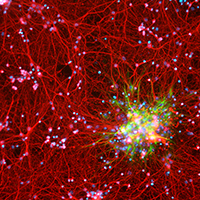Quantitative, structural and molecular changes in neuroglia of aging mammals: A review

Accepted: 27 May 2021
HTML: 11
All claims expressed in this article are solely those of the authors and do not necessarily represent those of their affiliated organizations, or those of the publisher, the editors and the reviewers. Any product that may be evaluated in this article or claim that may be made by its manufacturer is not guaranteed or endorsed by the publisher.
Authors
The neuroglia of the central and peripheral nervous systems undergo numerous changes during normal aging. Astrocytes become hypertrophic and accumulate intermediate filaments. Oligodendrocytes and Schwann cells undergo alterations that are often accompanied by degenerative changes to the myelin sheath. In microglia, proliferation in response to injury, motility of cell processes, ability to migrate to sites of neural injury, and phagocytic and autophagic capabilities are reduced. In sensory ganglia, the number and extent of gaps between perineuronal satellite cells – that leave the surfaces of sensory ganglion neurons directly exposed to basal lamina– increase significantly. The molecular profiles of neuroglia also change in old age, which, in view of the interactions between neurons and neuroglia, have negative consequences for important physiological processes in the nervous system. Since neuroglia actively participate in numerous nervous system processes, it is likely that not only neurons but also neuroglia will prove to be useful targets for interventions to prevent, reverse or slow the behavioral changes and cognitive decline that often accompany senescence.
How to Cite
PAGEPress has chosen to apply the Creative Commons Attribution NonCommercial 4.0 International License (CC BY-NC 4.0) to all manuscripts to be published.
Similar Articles
- Martin Boháč, Ľuboš Danišovič, Ján Koller, Jana Dragúňová, Ivan Varga, What happens to an acellular dermal matrix after implantation in the human body? A histological and electron microscopic study , European Journal of Histochemistry: Vol. 62 No. 1 (2018)
- S. Nemolato, T. Cabras, M.U. Fanari, F. Cau, M. Fraschini, B. Manconi, I. Messana, M. Castagnola, G. Faa, Thymosin beta 4 expression in normal skin, colon mucosa and in tumor infiltrating mast cells , European Journal of Histochemistry: Vol. 54 No. 1 (2010)
- Jing Guo, Chang-Yong Tong, Jian-Guang Shi, Xin-Jian Li, Xue-Qin Chen, Deletion of osteopontin in non-small cell lung cancer cells affects bone metabolism by regulating miR-34c/Notch1 axis: a clue to bone metastasis , European Journal of Histochemistry: Vol. 67 No. 3 (2023)
- Hui Yang, Yunlong Zhang, Desheng Zhang, Liping Qian, Tianxing Yang, Xiaocheng Wu, Crocin exerts anti-tumor effect in colon cancer cells via repressing the JAK pathway , European Journal of Histochemistry: Vol. 67 No. 3 (2023)
- Cuihong Jiang, Feng Liu , Shuai Xiao, Lili He, Wenqiong Wu, Qi Zhao, miR-29a-3p enhances the radiosensitivity of oral squamous cell carcinoma cells by inhibiting ADAM12 , European Journal of Histochemistry: Vol. 65 No. 3 (2021)
- M. Acosta, V. Filippa, F. Mohamed, Folliculostellate cells in pituitary pars distalis of male viscacha: immunohistochemical, morphometric and ultrastructural study , European Journal of Histochemistry: Vol. 54 No. 1 (2010)
- L. M. Carrillo, E. Arciniegas, H. R. Rojas, R. E. Ramirez, Immunolocalization of endocan during the endothelial-mesenchymal transition process , European Journal of Histochemistry: Vol. 55 No. 2 (2011)
- Chiara Rita Inguscio, Flavia Carton, Barbara Cisterna, Manuela Rizzi, Francesca Boccafoschi, Gabriele Tabaracci, Manuela Malatesta, Low ozone concentrations do not exert cytoprotective effects on tamoxifen-treated breast cancer cells in vitro , European Journal of Histochemistry: Vol. 68 No. 3 (2024)
- R. Ambu, L. Vinci, C. Gerosa, D. Fanni, E. Obinu, A. Faa, V. Fanos, WT1 expression in the human fetus during development , European Journal of Histochemistry: Vol. 59 No. 2 (2015)
- A. Porzionato, G. Fenu, M. Rucinski, V. Macchi, A. Montella, L. K. Malendowicz, R. De Caro, KISS1 and KISS1R expression in the human and rat carotid body and superior cervical ganglion , European Journal of Histochemistry: Vol. 55 No. 2 (2011)
<< < 1 2 3 4 5 6 7 8 9 10 > >>
You may also start an advanced similarity search for this article.

 https://doi.org/10.4081/ejh.2021.3249
https://doi.org/10.4081/ejh.2021.3249










